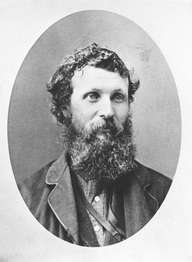Last updated: October 20, 2023
Place
Geology Tour - John Muirs Rockfall Experience

Historical/Interpretive Information/Exhibits
On March 26, 1872 the famed naturalist and conservationist, John Muir, was sleeping in a cabin nearby when he was shaken awake by a strong earthquake. This quake, known as the Owens Valley earthquake, was one of the largest earthquakes in California's history, with a magnitude of at least 7.5 on the Richter scale. This earthquake originated near the town of Lone Pine and shook most of eastern California and parts of Nevada. John Muir recounted his experience that night.
"...one morning about two o'clock I was aroused by an earthquake; and though I had never before enjoyed a storm of this sort, the strange, wild thrilling motion and rumbling could not be mistaken, and I ran out of my cabin, both glad and frightened, shouting, "A noble earthquake!" feeling sure I was going to learn something. The shocks were so violent and varied, and succeeded one another so closely, one had to balance in walking as if on the deck of a ship among the waves...
Then, suddenly, out of the strange silence and strange motion there came a tremendous roar. ... and I saw ... falling ... thousands of ... great boulders ...pouring to the valley floor in a free curve luminous from friction, making a terribly sublime and beautiful spectacle-an arc of fire fifteen hundred feet span, as true in form and as steady as a rainbow, in the midst of the stupendous roaring rock-storm. It seemed to me that if all the thunder I ever heard were condensed into one roar it would not equal this rock roar at the birth of a mountain talus."
The arc of fire that Muir saw was due to a phenomenon call triboluminescence. This occurs when quartz strikes against more quartz, creating sparks. As granite contains abundant quartz, the grinding and pulverizing of rocks as they tumbled down the cliff looked to Muir like streaks of orange fireworks. As you look towards the cliff, many of the boulders you see are likely from this event. Many other rockfalls occurred in Yosemite that night as a result of the violent shaking, including one near Nevada Fall that knocked an old hotel there off its foundation. The rockfalls triggered by the 1872 earthquake are among the largest in Yosemite's recorded history but they are small compared to some ancient rockfalls that occurred deeper in Yosemite's past. The boulders on either side of the trail here are from a much larger rockfall than the one John Muir observed.
When a rockfall occurs, it exposes a scar of fresh white granite on the cliff, and the resulting talus also gleams with fresh granite. You'll notice that most of the boulders along the trail here are covered with lichen and moss. This tells us that these boulders have been sitting here undisturbed for a very long time. In fact, we have dated this rockfall, using a technique that determines how long the boulders have been exposed on the surface, and we found that it occurred about 3,000 years ago. This rockfall was so large that it traveled all the way to the Merced River. Extremely large rockfalls like this are called rock avalanches. This particular rock avalanche is made up of nearly one and a half million tons of rock! We have dated the other rock avalanches in Yosemite and found that there is a strong link to earthquakes, just as John Muir observed on that fateful night in 1872. As you make your way to the final stop on this tour, look around at the vast field of boulders and imagine the chaos that took place here just a few thousand years ago.
